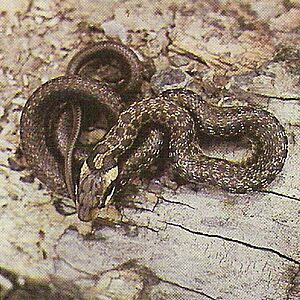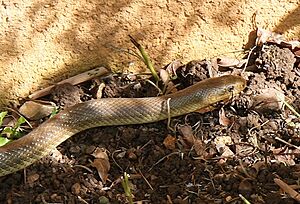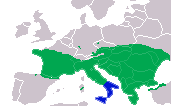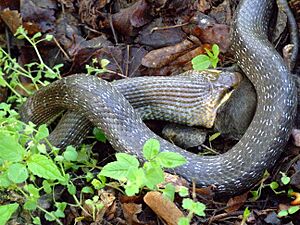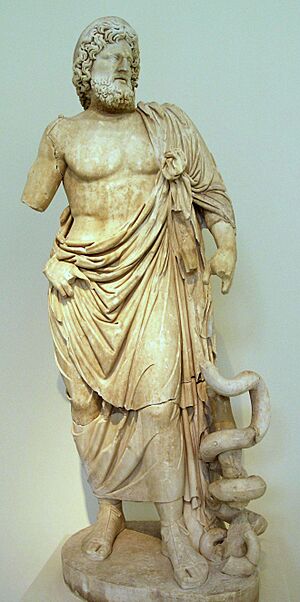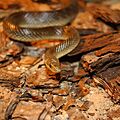Aesculapian snake facts for kids
Quick facts for kids Aesculapian snake |
|
|---|---|
 |
|
| Adult Z. longissimus from the region of Ticino, Switzerland. | |
| Conservation status | |
| Scientific classification | |
| Genus: |
Zamenis
|
| Species: |
longissimus
|
| Synonyms | |
|
|
The Aesculapian snake (scientific name: Zamenis longissimus) is a type of snake found in Europe. It is not venomous, meaning it's not poisonous. This snake belongs to the Colubridae family. It can grow up to 2 meters (about 6.5 feet) long, making it one of the biggest snakes in Europe.
The Aesculapian snake has been important in history and culture. It played a role in ancient Greek and Roman stories about Asclepius, the god of healing. This is why it's often shown wrapped around a staff, which is a symbol for doctors and medicine today.
Contents
What Does the Aesculapian Snake Look Like?
When they hatch, young Aesculapian snakes are about 30 centimeters (12 inches) long. Adult snakes are usually between 110 cm (43 inches) and 160 cm (63 inches) long. Some can even reach 200 cm (79 inches), with the longest ever found being 225 cm (89 inches). Adult snakes typically weigh between 350 and 890 grams (0.7 to 2 pounds).
These snakes are usually dark and slender. They often have a bronze color with smooth scales that look a bit shiny.
Young Snakes vs. Adults
Young Aesculapian snakes can look a lot like young grass snakes. This is because young Aesculapian snakes have a yellow collar around their neck. This yellow collar might even stay for a while on younger adult snakes.
Young Z. longissimus are light green or brownish-green. They have darker patterns on their sides and back. Their heads also have special dark spots.
Adult snakes look more plain. They can be olive-yellow, brownish-green, or even almost black. Sometimes, adults have small white spots all over their body. Their belly is usually plain yellow or off-white. Their eyes have an amber or orange color. Very rarely, you might see a black (melanistic), reddish (erythristic), or white (albinotic) Aesculapian snake.
Male snakes usually grow longer than females. This is because females use more energy for laying eggs. Aesculapian snakes can live for about 25 to 30 years.
Where Do Aesculapian Snakes Live?
The Aesculapian snake lives in many parts of Europe. You can find them in most of France, parts of Spain, Italy (but not the very south or Sicily), and across the Balkan peninsula down to Greece. They also live in parts of Central and Eastern Europe, including Switzerland, Austria, Hungary, Slovakia, Romania, and parts of Ukraine.
There are also smaller groups of these snakes in western Germany and the northwest Czech Republic. Another group lives south of the Greater Caucasus mountains, near the Black Sea.
Some people believe that the ancient Romans might have helped spread these snakes. The Romans kept these snakes in temples dedicated to Asclepius, the god of medicine. They might have released them in new areas.
Italian Aesculapian Snake
The Aesculapian snakes found in southern Italy and Sicily are now considered a separate species. They are called the Italian Aesculapian snake (Zamenis lineatus). These snakes are lighter in color and have reddish-orange eyes.
Past Homes
Fossils show that Aesculapian snakes lived as far north as Denmark a long time ago, when the climate was warmer. They also lived in the UK during warmer periods between ice ages.
Snakes in Great Britain
There are three groups of Aesculapian snakes in Great Britain that are not native. These snakes are descendants of ones that escaped from captivity.
- The oldest group is near the Welsh Mountain Zoo in North Wales. They have been living and reproducing there since the 1970s. In 2022, there were about 70 adult snakes in this group.
- A second group was found in 2010 along Regent's Canal near the London Zoo. They likely eat rats and mice. This group is thought to have a few dozen snakes.
- In 2020, a third group was confirmed in Bridgend, Wales. This group has been doing well for about 20 years.
These escaped snakes are not considered harmful or invasive. The Aesculapian snake is currently the only non-native snake species in the United Kingdom that has established breeding groups.
Where Do They Like to Live?
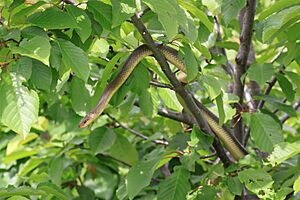
Aesculapian snakes like places that are warm but not too hot, and a bit humid but not wet. They prefer hilly or rocky areas with sunlight and different types of plants. This helps them control their body temperature.
They are often found in forests with broadleaf trees, especially near river valleys. They also like forest clearings, bushy areas at the edge of forests, and places where woods meet fields. These snakes don't usually avoid people. They are often found in gardens, sheds, old walls, and ruined buildings. These spots offer many places to hide and warm up in the sun. In colder northern areas, they rely more on human structures for warmth and food. They do not like open plains or large farms.
In the south, their range stops where forests turn into dry Mediterranean shrublands, which are too dry for them. In the north, their presence is limited by temperature.
What Do They Eat and What Eats Them?
Aesculapian snakes mainly eat rodents, like mice and rats. They can even overpower a 200-gram (7-ounce) rat. They also eat other small mammals such as shrews and moles. Birds, bird eggs, and baby birds are also part of their diet.
They kill their prey by squeezing it (constriction). Smaller prey might be eaten alive or simply crushed by their jaws. Young snakes mostly eat lizards and insects, and later, small rodents. Sometimes, they eat other snakes and lizards, but this is rare for adults.
Who Are Their Predators?
Animals that hunt Aesculapian snakes include badgers, foxes, and wild boars. Wild boars mainly dig up and eat their eggs and newborns. Hedgehogs and various birds of prey also hunt them. However, adult snakes have been known to defend themselves against birds.
Young snakes can be eaten by smooth snakes and other snakes that eat reptiles. Domestic animals like cats, dogs, and chickens can also be a threat, especially to young snakes. Even rats can be dangerous to adult snakes when they are hibernating. In some areas, raccoons and raccoon dogs, which were brought from other places, also prey on them.
How Do They Behave?
Aesculapian snakes are active during the day. In warmer months, they come out in the late afternoon or early morning. They are excellent climbers and can even climb straight up tree trunks without branches. Snakes have been seen as high as 4 to 5 meters (13 to 16 feet) and even 15 to 20 meters (49 to 66 feet) in trees. They also look for food in the roofs of buildings.
They are most active when the temperature is around 20-22°C (68-72°F). They rarely move around if it's colder than 16°C (61°F) or hotter than 25°C (77°F). If it gets too hot, around 27°C (81°F) or more, they try to avoid direct sunlight and stop moving. Even during winter hibernation, they might move a little to stay warm, sometimes coming out to sunbathe on sunny days.
These snakes are often secretive and can be hard to find, even in places where they are known to live. When they meet humans, they can be quite calm. They usually try to hide, but if they feel trapped, they might try to scare you. They might make a chewing motion with their mouth and sometimes even bite.
It's thought that these snakes might be more common than we realize because they spend a lot of time in tree canopies. In France, they are said to be the only snake species found inside dense, shady forests. This is probably because they use the tree leaves for sunbathing and hunting.
How Do They Reproduce?
Aesculapian snakes start reproducing when they are about 85–100 cm (33–39 inches) long, which is usually when they are 4–6 years old. They breed once a year after they wake up from hibernation in spring, usually from mid-May to mid-June. During this time, males and females actively look for each other.
Male snakes might have ritual fights to show who is stronger. They try to pin down the other male's head. Biting can happen but is not common. The male and female then perform an elegant dance, raising the front parts of their bodies in an S-shape and wrapping their tails together. The male might also gently hold the female's head with his jaw.
About 4 to 6 weeks later, the female lays around 10 eggs. The number of eggs can range from 2 to 20, but usually it's between 5 and 11. She lays them in a warm, moist place where organic material is decaying. This could be under hay piles, in rotting wood, manure heaps, or old tree stumps. In colder areas, several females might use the same nesting spot, sometimes even sharing it with grass snakes. The eggs hatch after about 8 weeks (it can be anywhere from 6 to 10 weeks).
History of Their Name
The Aesculapian snake was first described in 1768. It has had several scientific names over time, but its current name is Zamenis longissimus. The name Zamenis comes from a Greek word meaning "angry" or "fierce." Longissimus comes from Latin and means "longest," because it's one of the longest snakes in its range.
The common name "Aesculapian snake" refers to the ancient Greek god of healing, Asclepius (or Aesculapius in Roman mythology). These snakes were often kept around his temples. It is believed that the famous symbol of medicine, a staff with a snake wrapped around it, shows this very snake. This symbol is still used today by doctors and medical groups.
Conservation
Even though the Aesculapian snake lives in many places and is not currently endangered as a species, its numbers are generally decreasing. This is mostly because of human activities. The snake is especially vulnerable in the northern and edge parts of its range. In these areas, the groups of snakes are isolated from each other, meaning they can't mix their genes or get new snakes from other areas. Because of this, these local groups need active protection.
In Germany, the Aesculapian snake is listed as Critically Endangered. It is also protected in many other countries, including France, Switzerland, Austria, the Czech Republic, Slovakia, Hungary, Poland, Ukraine, and Russia.
One of the biggest problems for these snakes is when humans destroy their habitat. This includes building new things or changing forests and farms. Experts recommend protecting the snakes' main living areas, especially places where they lay eggs and hibernate.
Roads are also a big threat. New roads and more traffic can break up snake populations. This makes it harder for them to move around and find mates, which can lead to a loss of genetic diversity.
Gallery
Images for kids
-
The Aesculapian snake with the Bowl of Hygieia as a symbol of pharmacology.
See also
- List of reptiles of Italy
- List of snake genera
- List of reptiles of Europe



